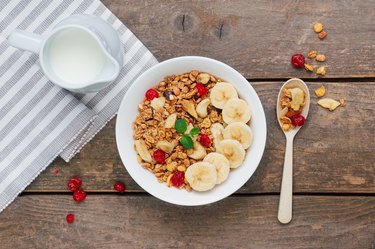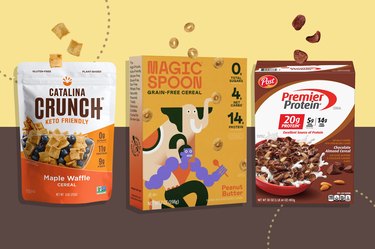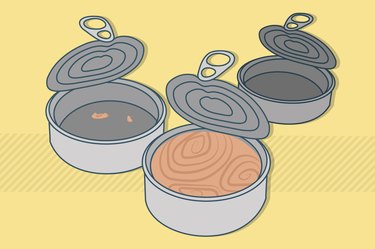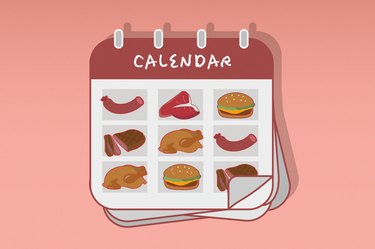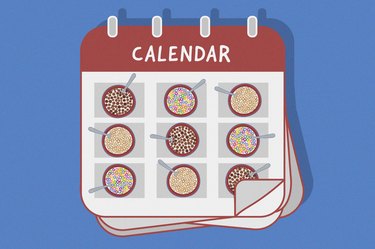
Generations of Americans grow up enjoying a bowl of cereal for breakfast. There's something satisfying about waking up to the hearty crunch of cereal over cold milk and some fresh fruit. But in recent years, cereal has gotten a lot of flack for essentially being glorified "cookies."
For example, a serving of Froot Loops cereal has 12 grams of added sugar — that's 24 percent of the recommended daily value and almost half the American Heart Association's (AHA) daily added sugar limit of 25 to 36 grams.
Video of the Day
Video of the Day
But that doesn't mean that you should say sayonara to all cereal — even your sugary childhood favorite. Like many foods, not all cereals are made equally, and some provide an accessible and convenient way to get important nutrients your body needs.
And as for the stuff that's laced with refined sugar? There's nothing wrong with having a bowl of it every now and then, and you shouldn't feel bad about eating it.
Ahead, we ask experts to break down the risks and benefits of eating cereal every day and share tips for choosing the most nutritious options and crafting a well-balanced meal or snack.
How Is Cereal Made?
Whether it's honey nut O's or corn flakes, cereal is made from milled grains and oats that are prepared in a way such that it reduces the amount of at-home cooking, according to the Environmental Protection Agency (EPA).
Breakfast cereals are categorized as cold cereal and hot cereals (such as old-fashioned oatmeal, which needs to be cooked further at home). In the traditional sense of the word, cereal is the kind you can pour right out of the box and eat.
"These ready-to-eat, pour-out-of-the-box cereals are made through a series of processing steps, and the process is slightly different for each type of cereal, whether it's flaked or puffed," says Amber Trejo, RDN, registered dietitian and founder of Naked Wellness. "The steps cereals go through are pre-processing, mixing, cooking, de-lumping, drying process, cooling, drying process again and then packaging."
What's Considered 'Healthy' Cereal?
In September 2022, the U.S. Food and Drug Administration (FDA) came out with guidelines that state when foods can be labeled with the claim “healthy” on the packaging. According to their proposed criteria, a cereal would need to have ¾ ounces of whole grains and fewer than 1 gram of saturated fat, 230 milligrams of sodium and 2.5 grams of added sugars to be considered healthy.
The Health Risks of Eating Cereal Every Day
1. It Can Destabilize Your Blood Sugar Levels
Depending on the type of cold cereal you choose, eating it every day as a meal might not be the most nourishing choice.
For example, cereal that's loaded with added sugar and has little fiber can cause your blood sugar levels to skyrocket and then fall quickly, which can make you feel hungry soon after eating it, so it is less satisfying, says Dena Champion, RDN, a registered dietitian at the Ohio State University Wexner Medical Center.
"Eating a sugary cereal with minimal nutritional value is not a great daily option. A breakfast high in sugar leaves less room for more nutritional options," she says.
Most Americans eat more added sugar than is recommended, and added sugar is associated with an increased risk of heart disease mortality, according to an April 2014 review in JAMA Internal Medicine. A diet high in sugar is also associated with an increased risk for high blood pressure, high cholesterol, diabetes and obesity, per the AHA.
"It's recommended to limit added sugar to 6 to 9 teaspoons daily for adults and under 6 teaspoons for children under 18," Trejo says.
2. It's Linked to Cancer and Behavioral Issues
Many different kinds of cereals, especially those targeted toward children, are made with artificial food dyes that have been found to be carcinogenic in animal studies. Many FDA-approved synthetic food dyes are derived from petroleum and coal sources, which is where the health concerns stem from.
For example, a November 2013 review in the International Journal of Occupational and Environmental Health found that red 3, an approved food dye, causes cancer in animals and that other food dyes, such as red 30, yellow 5 and yellow 6, are contaminated with benzidine (a chemical linked to cancer) and other carcinogens.
It's worth noting that benzidine isn't found in the food itself but is in dyes that have impurities that can be broken down into benzidine inside your body, according to the Department of Health and Human Services.
"Food dyes are very controversial in the United States, as Europe has banned several FDA-approved food colorings. Artificial food colorings are categorized as 'generally recognized as safe' (GRAS) when eaten at low levels," Trejo says. "However, much of today's food products have some type of artificial coloring. If you're overconsuming these dyes, there is a risk of cancer as well as behavioral issues, like ADHD, in children."
So it's best to limit your intake of cereals high in sugar and made with artificial food colorings if you want to eat cereal daily, she says.
The Benefits of Eating Cereal Every Day
1. It's an Easy Way to Get a Nutritious Breakfast
Cereal can be a nutritious breakfast choice if you choose ones that are made with whole grains, fiber and protein and pair them with fruits, nuts and seeds and milk, Champion says. In fact, you can find plenty of nutrient-dense cereals that are much lower in added sugars and feature a variety of whole grains.
Just like any meal, an ideal breakfast is one that has good sources of carbohydrates, fat, fiber, protein and other nutrients. So choosing a cereal that checks off some of these essential components and is paired with other nutrient-dense foods can be beneficial if eaten daily.
For example, having a bowl of cereal with dairy milk or calcium-fortified plant milk is a great way to get calcium, Champion says.
And whole-grain cereals provide fiber, which is essential for multiple reasons. "Fiber is a key nutrient for heart health and cholesterol management, and helps with satiety, which is important [for] weight-loss efforts," Trejo says.
"Fiber is also an important nutrient for blood-sugar stabilization. Some cereals even incorporate nuts and seeds into their mix. Nuts and seeds provide vitamins and minerals that are needed as part of a healthy diet, such as copper, selenium and vitamin E," Trejo says.
Tip
If your cereal doesn't have nuts or seeds, you can add them, along with some fresh or frozen fruit. Berries, bananas, peaches and grapes are some of Champion's top choices.
2. It Can Double as a Pre-Workout Snack
Here's a little secret: You don't have to avoid eating your favorite sugary cereal — there's a place for it in your diet, and having it as a pre-workout snack is a perfect time to dig in.
"In certain instances like exercise, eating simple carbohydrates would be a great fuel source. I am a huge fan of cereal as a pre-workout snack. Our bodies need carbohydrates for energy, and simple carbohydrates, like in some cereals, would be a good choice because it proves fast-acting glucose to fuel our physical activity," Trejo says.
Even if you're not working out, the sugary stuff can be a nice treat, like any other dessert, to have in moderation. "Sugar tends to get demonized under all circumstances, but there is a time and place for sugar!," Champion says.
Plus, cereal is pretty affordable, and it can last for several meals and snacks.
How to Choose Nutritious Cereals
1. Opt for Cereals Made With Whole Grains
When shopping for cereals, make sure a whole grain is the first ingredient on the ingredients list, Trejo says. Whole grains include whole wheat, amaranth, barley, millet, oats and quinoa, according to the Whole Grains Council.
"The ingredient that is listed first is what that item is mostly made of," Trejo says. So that means if whole-grain oats are the first ingredient, then the cereal is made up of mostly oats.
"The second thing to look for is a fiber amount that has at least 3 grams of fiber per serving," Trejo says.
2. Go for Lower-Sugar Options
Trejo likes to shop for cereals that have 10 grams of sugar or less — and according to the FDA guidelines, a "healthy" cereal will have no more than 2.5 grams of added sugar.
If you're craving some sweetness in your bowl, add some fruit. Or, you can mix your favorite sugary cereal with a plain option. "This can satisfy that craving and provide a better way to start the day," Champion says.
Tips for Making Your Bowl of Cereal More Nutritious
- Add fresh or frozen fruit, such as berries, bananas and apples
- Enjoy it with milk. "While cereal can be part of a healthy diet, it's not quite a complete, balanced meal without adding milk. This is because milk will add some fat and high-quality protein to your cereal bowl," Trejo says. If you have a dairy sensitivity or don't like cow's milk, Trejo recommends Good Karma flax milk because it has 8 grams of pea protein.
- Sprinkle nuts and seeds, like walnuts, pistachios, chia seeds and hemp seeds, for more protein and fiber and healthy fats. "I love adding hemp hearts or chia seeds for plant sources of omega-3 fats.
So, Is Eating Cereal Every Day Really That Bad?
It's completely fine to enjoy cereal every day, as long as you're choosing nutritious options and meeting your nutritional needs by pairing it with other foods, like fruit, nuts and seeds and unsweetened milk.
Pouring a bowl of sugary cereal is OK, too, in moderation, of course, and it's particularly good as a pre-workout snack.
"I do think it's a great idea for people to vary the fruits and vegetables they eat, if possible, because they provide different nutrients and phytochemicals," Champion says. "For example, instead of using a banana in your cereal every day, maybe try rotating a few types of fruits that you like. Same for nuts — instead of one nut daily, try a combination or rotate them."
- American Heart Association: "Added Sugars"
- American Heart Association: "Added Sugar Is Not So Sweet - Infographic"
- International Journal of Occupational and Environmental Health: "Toxicology of Food Dyes"
- Department of Health and Human Services: "Public Health Statement: Benzidine"
- Food and Drug Administration: "Color Additives Questions and Answers for Consumers"
- Whole Grains Council: "Whole Grains A to Z"

